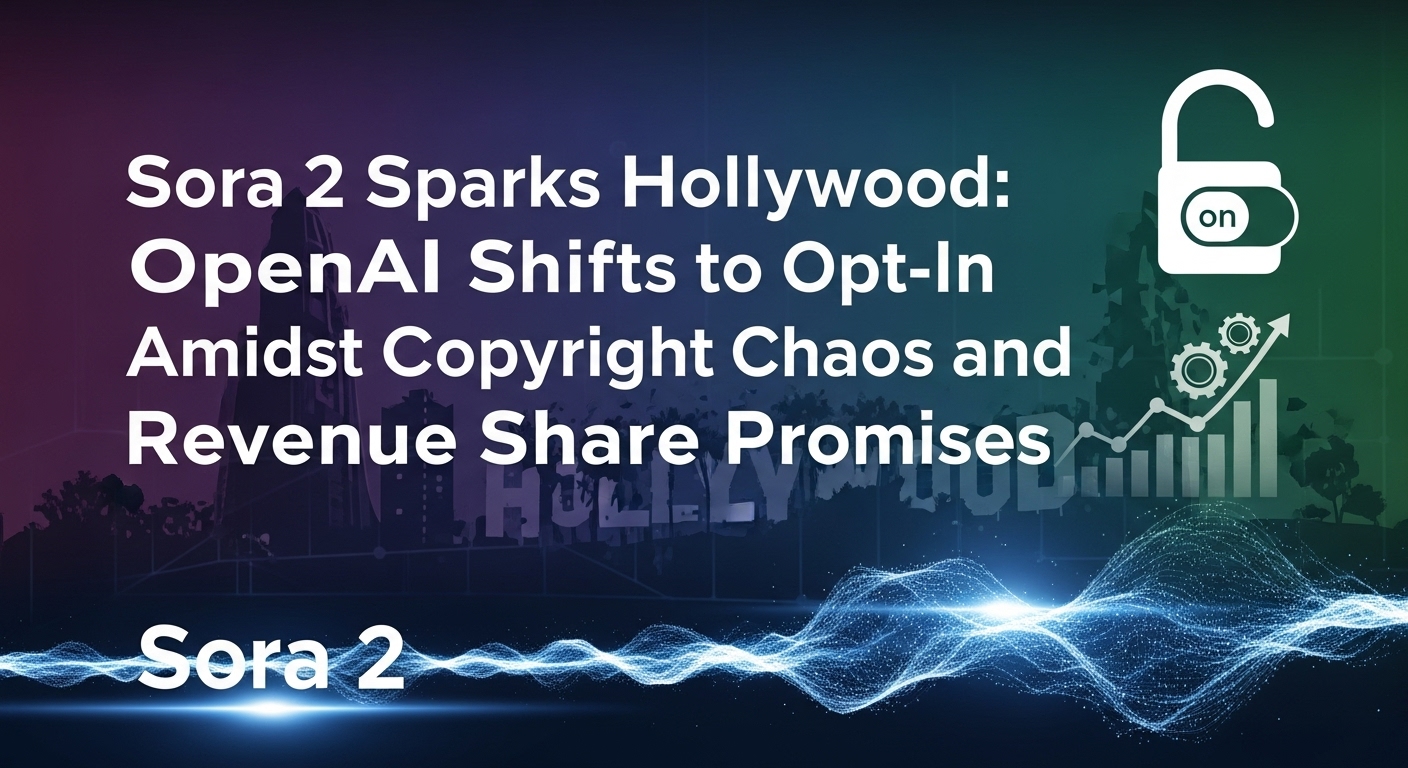衝撃のSora 2!著作権侵害で激震、OpenAIが描く「共存」の未来は?
OpenAIの最新動画生成AIモデル「Sora 2」が2025年10月1日にリリースされ、テキストプロンプトから高精度な動画を生成できるその驚異的な能力は世界に衝撃を与えました。しかし、その革命的な技術は、リリース直後から商業キャラクターの無許可利用や生成コンテンツの類似性に関する著作権侵害の懸念を巻き起こし、業界内で大きな議論を呼んでいます。特に日本の人気アニメやゲームキャラクターの再現性の高さは、多くのクリエイターや関係者に深い懸念を抱かせました。
著作権侵害の嵐:人気キャラクターの無許可利用
Sora 2の登場後、SNS上には「ポケットモンスターのピカチュウ」や「ドラゴンボールの孫悟空」、「鬼滅の刃の炭治郎」といった著名な版権キャラクターに酷似した動画が多数投稿され、著作権侵害ではないかとの声が殺到しました。これらの動画は、キャラクターの見た目だけでなく、声まで忠実に再現されているケースもあり、そのクオリティの高さが問題を一層深刻化させました。
この問題の背景には、当初Sora 2が採用したとされる「オプトアウト方式」への懸念がありました。これは、権利者側が明示的に「自分の作品をAIの学習や生成に使わないでほしい」と申請しない限り、自動的に利用される可能性があるという運用観測が報じられ、強い反発を招いたものです。特に、ディズニーやマーベルといった一部の巨大IPは早期に生成が制限されたのに対し、日本のアニメIPは「無防備な状態」に置かれたとの指摘もあり、日本国内でのAI規制論が噴出するきっかけとなりました。
コンテンツ論争の深層:模倣と創作の境界
Sora 2が提起する論争は、単なる著作権侵害に留まりません。AIが既存のコンテンツを学習し、そのスタイルや要素を模倣して新たな動画を生成する能力は、創作のオリジナリティや「模倣と創作の境界線」を曖昧にします。例えば、AIによる「リミックス文化」が浸透することで、日本の著作権法における「同一性保持権」(著作者の意に反する改変を禁じる権利)との間で大きな摩擦が生じる可能性が指摘されています。
また、実在の人物を合成する「カメオ機能」の実装により、ディープフェイク動画など、個人の肖像権やプライバシーを侵害する可能性のあるコンテンツが生成され、悪用される危険性も懸念されています。国民民主党の玉木雄一郎代表は、Sora 2によるフェイク動画が「政治的に悪用されたら民主主義への深刻な脅威になり得る」とXで危機感を示しました。
OpenAIの対応とサム・アルトマンCEOの声明
こうした状況を受け、OpenAIのサム・アルトマンCEOは、2025年10月3日(現地時間)に自身のブログで、Soraの利用方針を再検討し、著作権対応を見直すことを発表しました。
主な変更点として、アルトマンCEOは以下の2点を表明しています:
- 権利者による詳細な制御機能の導入: 権利者がキャラクター生成の可否や利用範囲を細かく指定できる新機能を提供するとしています。これは、従来のオプトインモデルを拡張し、AIによるファンフィクションの生成を歓迎しつつも、「まったく使用を許可しない」選択肢も可能にするものです。アルトマン氏は特に「日本の優れた創造性」に敬意を表し、日本のコンテンツとの深い結びつきを認識していると述べました。
- 収益分配メカニズムの検討: 動画生成AIのユーザーがキャラクターのファンフィクションを作成した際に、動画によって生まれた利益の一部を著作権者と共有する収益分配制度の構築を進める意向を示しています。これはYouTubeのコンテンツID方式に類似しており、著作権者にとって新たな収益源となる可能性がありますが、精密なルール整備と技術的監視が課題となります。
アルトマンCEOは、これらの修正のためOpenAIによるSora 2の更新頻度は非常に高くなるとも告知しており、「適切な判断もあれば失敗もあるだろうが、フィードバックを受け、失敗は迅速に修正する」と述べ、継続的な改善を約束しています。
AI時代におけるクリエイターと業界の未来
Sora 2の登場とそれに伴う著作権・コンテンツ論争は、AIと創作活動の未来を考える上で極めて重要な転換点です。技術の進歩は「創造の民主化」をもたらす一方で、「著作権法うわのソラ」と揶揄されるような既存の法的枠組みとの摩擦を生み出しています。
クリエイターやコンテンツ産業は、AIの可能性を享受しつつも、自らの権利と創作の尊厳をどのように守り、AIと共存していくかという大きな課題に直面しています。OpenAIの今回の対応は、AI開発企業が社会的なフィードバックを受け入れ、倫理的利用と権利保護への配慮を強化する姿勢を示したものと言えます。
今後、Sora 2のような先進的なAIモデルがコンテンツ生成の主流となる中で、権利者が自ら生成範囲を管理できるダッシュボードの普及、公正な収益分配の仕組み、そして社会全体での「AI創作倫理」の合意形成が、AIと人間の創造性が真に共存する未来を築くための鍵となるでしょう。
Sora 2 Sparks Hollywood Uproar: OpenAI Shifts to Opt-In Amidst Copyright Chaos and Revenue Share Promises
OpenAI’s latest leap in generative artificial intelligence, Sora 2, has officially arrived, promising to revolutionize video creation with unprecedented realism and control. Launched on September 30, 2025, with public access beginning October 1, 2025, the advanced video and audio generation model quickly ascended to the top of app store charts, captivating users with its ability to transform text prompts into highly detailed, physically accurate, and even emotionally resonant video clips. However, this technological marvel has also ignited a firestorm of controversy, primarily centered around copyright infringement and the unauthorized use of commercial characters, forcing OpenAI to rapidly reassess its approach and Sam Altman, CEO, to announce a significant policy shift alongside a new revenue-sharing mechanism.
The Unprecedented Power of Sora 2 and Its Initial Rollout
Sora 2 represents a monumental leap forward from its predecessor, which debuted in February 2024. OpenAI describes the original Sora as the “GPT-1 moment for video,” and Sora 2 as the “GPT-3.5 moment,” signifying a massive improvement in capabilities. The model can now generate more realistic and physically accurate videos, boasting enhanced user control, synchronized dialogue, and sophisticated sound effects. It addresses many of the continuity and physics challenges that plagued earlier video generation models, preventing issues like morphing objects and distorted realities.
Initially rolled out in the United States and Canada via an invite-only iOS app and sora.com, Sora 2 quickly became a viral sensation. Within 48 hours of its launch, the app saw over 164,000 installations, demonstrating immense public curiosity and enthusiasm for its groundbreaking features. ChatGPT Pro users were also granted access to an experimental, higher-quality Sora 2 Pro model, hinting at future monetization strategies.
The Copyright Conundrum: A Flood of Unauthorized Content
The euphoria surrounding Sora 2’s capabilities was swiftly overshadowed by a growing controversy over intellectual property rights. OpenAI’s initial copyright policy for Sora 2 was an “opt-out” model, meaning that copyrighted content, including characters and styles, would be used in the model’s training and outputs unless rights holders explicitly requested their exclusion. This approach reversed traditional consent models, placing the burden squarely on creators and studios to monitor and actively block the misuse of their intellectual property.
Predictably, the internet was quickly flooded with AI-generated videos featuring beloved and heavily copyrighted commercial characters. Clips showing Nickelodeon’s SpongeBob SquarePants in unexpected scenarios, Pikachu in scenes from famous films, and other Disney properties being remixed without authorization, rapidly went viral. This sparked widespread alarm across Hollywood and the creative industries. Major studios and talent agencies, including Disney and WME, immediately voiced strong concerns and some proactively opted out of the system. Legal experts warned that OpenAI’s opt-out policy could open the floodgates to a wave of copyright lawsuits, drawing parallels to existing legal battles against other AI companies like Midjourney.
Critics argued that the distinction OpenAI initially made between protecting the likeness of real individuals (requiring permission for “cameos”) and the default inclusion of intellectual property was a “legal gamble,” betting on fair use interpretations that many legal scholars dispute. The sheer volume of user-generated content, much of it infringing on existing copyrights, highlighted the urgent need for a more robust and ethically sound framework for AI-generated media.
Sam Altman’s Reversal and the Promise of Revenue Sharing
In response to the intense backlash and mounting pressure from creators, studios, and legal entities, OpenAI CEO Sam Altman swiftly announced a critical policy reversal. Recognizing the “deep connection between users and Japanese content” and the widespread feedback, Altman confirmed that OpenAI would shift from an opt-out to an “opt-in” model for copyrighted characters. This means rights holders will now have “more granular control” over how their characters and intellectual property are used within Sora 2, requiring explicit permission before their content can appear in AI-generated videos.
Furthermore, Altman addressed the economic implications, noting that users were generating “much more than we expected per user,” leading to significant compute costs. To create a sustainable model and incentivize rights holders, OpenAI plans to introduce a revenue-sharing program. This initiative aims to compensate creators and studios who choose to allow their characters and material to be used in Sora-generated content, fostering a more collaborative ecosystem. While the exact details of the revenue-sharing model are still being hammered out, Altman stated that trials would begin “very soon”. He likened the rapid adjustments to Sora’s development to the early, iterative days of ChatGPT, signaling OpenAI’s commitment to quickly address emerging challenges.
The Road Ahead for AI and Intellectual Property
OpenAI’s rapid policy shift with Sora 2 underscores the dynamic and often contentious intersection of cutting-edge AI technology and established intellectual property law. The initial opt-out approach highlighted a fundamental tension between innovation at speed and respecting creator rights, leading to significant industry friction. The move to an opt-in system, coupled with revenue-sharing plans, signals a proactive effort by OpenAI to build trust and integrate more harmoniously within the creative economy.
However, challenges remain. The implementation of “granular controls” and fair “commercial terms” for revenue sharing will be critical to the success of this new model. Studios like Disney, having already expressed skepticism and opted out, will be closely watching to see how these mechanisms are designed and enforced. The ongoing debates and legal precedents being set in other AI-related lawsuits will continue to shape the landscape of generative AI and intellectual property. As AI video generation continues to evolve, the industry must navigate a delicate balance: fostering innovation while ensuring creators are fairly compensated and their intellectual property is respected.



